[PART FIVE] THE RESPONSE FROM DIOCESES AND
RELIGIOUS COMMUNITIES |
5.1 INTRODUCTION TO THE REPORTING OF CHILD SEXUAL ABUSE
Every published empirical study on the disclosure of child sexual abuse indicates that a high percentage of those child sexual abuse victims who report their abuse to authorities delay disclosure of their abuse and that a significant number of children do not disclose the abuse at all. [1] The delay between the initial occurrence and the subsequent disclosure of the abuse varies, depending on a number of factors such as the abused child’s age at the time of abuse, the relationship between the perpetrator and the child, the gender of the child, the severity of the abuse, developmental and cognitive variables related to the abused and the likely consequences of the disclosure.
Consequently, child sexual abuse is significantly underreported. When victims do report that they were abused, they often do so years after the abuse occurred. Adult retrospective studies of childhood sexual abuse underline the delay in disclosure. In a study of 228 adult female victims of childhood incest who were predominantly abused by males, Roesler and Weissmann-Wind found that the average age of first abuse was 6 years, and the abuse lasted on average 7.6 years. Only one-third of the subjects in this sample disclosed the abuse before the age of 18, and the average age of disclosure was 25.9. [2] Arata found that only 41% of the 204 female participants in her study, whose average age at the time of victimization was 8.5, disclosed the abuse at the time it occurred. [3] Lawson and Chaffin found that only 43% of their child subjects disclosed their abuse when they were initially interviewed. [4] Lamb and Edgar-Smith conducted a study with 45 adult female and 12 adult male victims of childhood sexual abuse, and they found that although the average age at the time of victimization was 10, 64% of the victims disclosed their abuse in adulthood. [5] In a study of childhood rape of girls, Smith, Letourneau and Saunders found that approximately half of the women waited more than eight years to disclose the abuse. [6]
If abuse is reported years after it occurred, there may be errors in the accuracy of the report due to “telescoping,” or the likelihood that an individual will report the event as happening earlier or later than it actually occurred. [7] Several social science studies have tested the telescoping phenomenon. Several studies found that forward-telescoping, or recalling a past event as having occurred more recently than it actually did, is more prevalent than backward telescoping. [8] One study showed that memory disorientations, such as telescoping, occur more often in survey respondents 55 years or older than respondents less than 55 years of age. [9] Another study portrayed survey participants as showing a tendency to forward-telescope events that were prominent in their lives. [10] In other words, these survey respondents showed a higher likelihood of recalling significant life events, such as crime victimization, as occurring more recently in time than the event actually did. Yet another study examined the existence of telescoping in crime victimization surveys and found that non-reported incidents were telescoped by respondents to a slightly greater extent than incidents reported to the police. [11]
This notion reveals a propensity for crime victims to telescope forward victimizations from their past, particularly if the crime was never reported to the police or criminal justice officials. Though telescoping has consistently been an issue in temporal reporting of a variety of abuses, [12] no empirical studies have examined this problem specifically with sexual abuse disclosure.
The process of disclosing childhood sexual abuse varies, though it is often described within two axes: as purposeful or accidental and as spontaneous or prompted. [13] DeVoe and Coulborn-Faller found that child subjects in their study required assistance with disclosure. [14] Sorenson and Snow noted that accidental disclosure was more common in preschool children whereas purposeful disclosure was more common in adolescents. They also found four stages of disclosure in their retrospective study of 630 subjects who were aged 3 to 17 at the time of abuse: denial, disclosure (tentative and active), recantation and reaffirmation. These researchers also found that 72% of their subjects originally denied the abuse; 78% of the subjects who tentatively revealed their abuse progressed to active disclosure; 22% recanted their reports, and of those who recanted 93% later reaffirmed the original report. [15] Lawson and Chaffin found that a significant factor in the disclosure process was the belief of the caretaker in the veracity of the disclosure. [16] Bradley and Wood’s research also supported the notion that the role of the caretaker is essential. Although recantations of disclosure were rare in their sample, they found that 50% of children who recanted did so under pressure from a caretaker. [17]
One model of child sexual abuse, the Child Sexual Abuse Accommodation Syndrome, helps explain the hindrance to disclosure. This syndrome is not intended to be diagnostic, but rather it is intended as a clinical tool to assist in putting abuse victim behavior in context. It consists of five components: secrecy (the abuse occurs when the victim and perpetrator are alone, and the perpetrator encourages the victim to maintain secrecy); helplessness (children are obedient to adults and will usually obey the perpetrator who encourages secrecy); entrapment and accommodation (once the child is helplessly entrenched in the abusive situation, he or she assumes responsibility for the abuse and begins to dissociate from it); delayed disclosure (because the victims who report child sexual abuse often wait long periods of time to disclose, their disclosures are subsequently questioned); and retraction (as in the recantation stage described by Sorenson and Snow, the victims may retract their disclosures of abuse after facing disbelief and lack of support after their disclosure). [18] Of course, not all victims react in predicted ways, but some broad patterns can be discerned.
FACTORS INFLUENCING DISCLOSURE
VICTIM’S RELATIONSHIP TO THE PERPETRATOR
If the perpetrator is a relative or acquaintance, victims of child sexual abuse are less likely to report the offense, or they are likely to disclose the abuse after a delay. [19]
In Arata’s study, 73% of the victims did not disclose the abuse when the perpetrator was a relative or stepparent, and 70% did not disclose when the perpetrator was an acquaintance. [20] Goodman-Brown, Edelstein, and Goodman found that those children who felt responsible for the abuse, often because the abuse occurred within the family, took longer to report the abuse. [21] Wyatt and Newcomb found that the women who did not disclose their abuse to anyone were likely to have been closely related to the perpetrator and abused in close proximity to their home. [22]
SEVERITY OF SEXUAL ABUSE
Research results vary in regard to disclosure of abuse in relation to the severity of that abuse. Arata found that child victims who experienced more severe levels of sexual abuse were less likely to disclose this type of abuse. [23] This is consistent with the findings of Gries, Goh, and Cavanaugh, who reported that fondling was reported by 80% of their subjects who disclosed. [24] In contrast, however, Hanson found that of their 341 adult females who were victims of childhood rape, the more severe assaults were likely to be reported. [25] DiPietro et al (1998) also found that contact sexual offenses were those most commonly reported in their sample of 76 children. [26]
DEVELOPMENTAL AND COGNITIVE VARIABLES
Lamb and Edgar-Smith speculate that “more astute” children may not disclose because they may “anticipate unsupportive reactions”. [27] They also maintain that such children may wait until adulthood to disclose when they can choose appropriate people to tell. White, as cited in Campis, found that older victims of child sexual abuse were less likely to disclose than their younger counterparts and noted that the knowledge of social consequences was a significant hindrance to disclosure. [28] Keary and Fitzpatrick concluded that children over the age of five, who had previously disclosed sexual abuse, were more likely to disclose this information during formal assessment, but the converse was true for children under five. [29] Similarly, DiPietro found that “developmental maturation clearly facilitates” disclosure. [30]
FEAR OF NEGATIVE CONSEQUENCES
Sorenson and Snow found that fear of further harm had an impact on a child’s motivation to disclose abuse and that child victims often only felt safe enough to disclose after the departure of the perpetrator. [31] Berliner and Conte also noted that the fear about perceived reactions of others prevent some children from disclosing sexual abuse. [32] Roesler and Weissmann-Wind found that 33.3% of their subjects did not disclose their abuse during childhood because they feared for their safety. They also found that 32.9% of their subjects did not report their abuse during childhood because they felt guilt or shame as a result of the abuse. [33]
GENDER DIFFERENCES
DeVoe and Coulborn-Faller; Gries, Goh, and Cavanaugh; Lamb and Edgar-Smith; and Walrath, Ybarra, and Holden all found that girls are more likely to report abuse than boys. [34] Reinhart found that sexual abuse of males was more likely to be disclosed by a third party. [35] There are no methodologically sound empirical studies that indicate that males disclose at a higher rate than females. Gender does not appear to be as important, however, as victim-perpetrator relationship in disclosure of abuse. [36]
[Notes for the previous section are collected in a note section at the end of the Web version of this report, and every reference in the text is hyperlinked to the note itself.]
[note 1 is on page 86, notes 2-24 are on page 87; and notes 25-36 are on page 88]
5.2 REPORTING OF ALLEGATIONS OF SEXUAL ABUSE
The shape of the distribution of incidents of alleged abuse, as was shown in Figure 2.3.1 in Part Two of this report, follows a regular curve, rising steadily from 1950 to its height in the mid-1970s and then steadily decreases until the end of the study period. Although the reporting of child sexual abuse follows a completely different pattern, as is shown in Figure 5.2.1, the distribution of abuse allegations over time that are reported in the peak year 2002, are not different from the overall pattern of events. As Figure 5.2.2 shows, the distribution of incidents reported in 2002 is very similar to that shown for all allegations reported over the 52 years that is the time frame of this study.
Figure 5.2.1 YEAR OF ABUSE REPORT
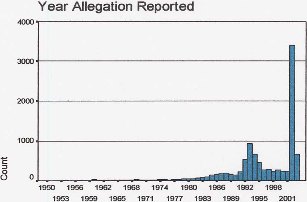 |
Figure 5.2.2 CASES REPORTED IN 2002, BY BEGIN DATE
 |
Table 5.2.1 INCIDENT BEGIN DATES REPORTED IN 2002 COMPARED TO ALL INCIDENTS
 |
Table 5.2.1 compares the decade by decade totals of alleged incidents for all reported incidents and for those reported in 2002. The pattern of abuse alleged in 2002 and over the entire study period is very similar.
Table 5.2.2 ABUSE REPORTS BY DECADE
 |
Table 5.2.2. shows the remarkable clustering of reports of child sexual abuse in and after the decade of the 1990s.
Figure 5.2.3 TIME FROM INCIDENT TO REPORT
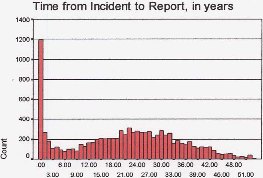 |
Half of the incidents of abuse were reported by individuals who experienced the victimization. Attorneys reported one in five incidents, followed by family members, who reported approximately 17%.
Table 5.2.3 SOURCE OF ABUSE REPORT
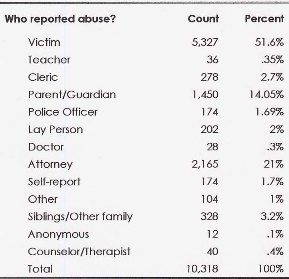 |
The reports of abuse came to the Church in many and varied ways. Phone calls and letters were the most commons forms of contact, followed by a legal filing by an attorney.
Table 5.2.4 FORM OF ABUSE REPORT
 |
There was at least one effort made to follow up the initial report in half of the incidents of sexual abuse reported from the Church files for this study.
TABLE 5.2.5 FOLLOW UP EFFORTS BY ALLEGED VICTIM OF ABUSE
 |
5.3 RESPONSE FROM DIOCESES AND RELIGIOUS COMMUNITIES
The response to the allegations of child sexual abuse by the bishops, major superiors and other priests who were presented with the problem was first shaped by the timing of the allegation. When all allegations are considered, only one in four allegations was made within ten years of the incident that gave rise to the allegation. Half of all allegations were made between ten and thirty years after the incident and the remaining 25% were reported more than 30 years after the incident.
Study data provided the researchers with two ways to understand the responses to allegations of child sexual abuse undertaken by dioceses and religious communities—responses to the formal survey questions and the notes and explanations that were added by those who completed the incident-level Victim Surveys. The Victim Survey questions addressed investigations, the results of those investigations and the actions prompted by the results. The handwritten notes on both Cleric and Victim Surveys were recorded and coded into a credibility scale to indicate whether the Church files on an individual priest reflected a conclusion that the allegation about his actions was credible or not credible.
The actions and responses of the Church to allegations are various and multiple: an individual priest may have been counseled, evaluated, provided with treatment, suspended, or limited in his priestly capacity. These actions are present whether the allegation was found to be or not to be credible or substantiated, but with different distributions. The survey data results for actions taken as a result of the allegations of child sexual abuse include the following:
• The Diocesan and Order Profiles reported that 298 priests and deacons had been completely exonerated. No surveys were completed for priests who were exonerated, and these individuals are not included in the study statistics.
• The handwritten annotations on the surveys indicated that for 1,671 priests the allegations were thought to be credible, and not credible for 345 priests.
• 9,281 Victim Surveys had information about an investigation. In 6,696 cases, or 72%, an investigation of the allegation was carried out.
• Of the alleged incidents investigated by the dioceses and religious communities, a definitive result of the investigation was reported for 5,681 cases. Of these cases, 4,570, or 80%, were substantiated; 1,028, or 18%, were unsubstantiated; 83, or 1.5%, were found to be false. Priests were reported to deny the allegations in 56 cases. Of the investigations that did not produce a definitive result, in many cases the priest was deceased at the time of the allegation or the investigation was ongoing at the time the survey was submitted to the study.
• When all Cleric Surveys are considered, 27% of all priests subject to an allegation had their ministry restricted by a superior.
The figures that follow show the distribution of responses and actions by the Church to allegations of abuse. The percentages apply to the number of surveys within each subgroup that had a response.
ACTIONS OF DIOCESES AND RELIGIOUS COMMUNITIES
PRIESTS WITH CREDIBLE ALLEGATIONS
Of the 1,671 surveys with written support for the credibility
of the allegation,
notes on 525 indicated strong support.
The percentages in this figure apply to the strongly-supported cases.
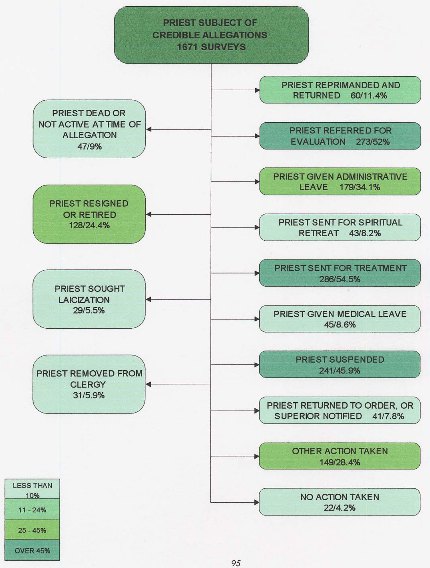 |
ACTIONS OF DIOCESES AND RELIGIOUS COMMUNITIES
PRIESTS WITH STRONGLY NON-CREDIBLE ACCUSATIONS
N = 215
 |
ACTIONS OF DIOCESES AND RELIGIOUS COMMUNITIES
PRIESTS WITH SUBSTANTIATED ALLEGATIONS
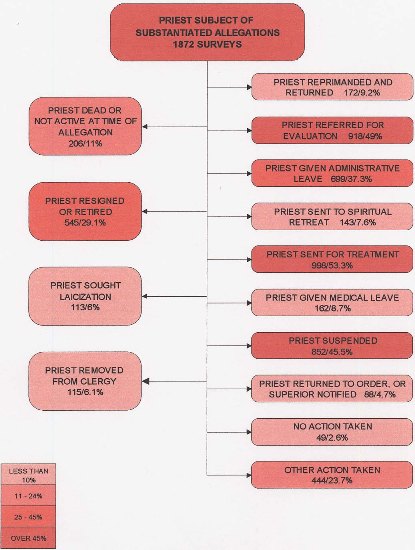 |
ACTIONS OF DIOCESES AND RELIGIOUS COMMUNITIES
PRIESTS WITH UNSUBSTANTIATED ALLEGATIONS
 |
Although the majority of the priests and deacons accused of child sex abuse have had only one allegation, there were two types who had inspired more concern – those priests who had multiple victims and those who abused one victim for a lengthy period of time. The aims and types of treatment for sexual offenders have changed significantly throughout the past century, which is important when understanding the types of treatment clergy have undergone since the 1950s. In the early 20th century, psychologists thought sexual offending was the result of individual psychological conflicts. As a result, many of the first treatments were psychoanalytic in nature. They were based upon a model, which implied that offending was out of the individual’s control. Early psychoanalysts believed that if treatment were to occur it would have to be lengthy in order to adequately address and resolve the problem. [1]
In the 1950s, psychological methods of treatment for sexual offenders began to change. [2] Many researchers at this time believed that deviant sexual practices resulted from deviant sexual arousal, and therapeutic practices were developed to modify deviant fantasies. They took various forms, such as operant conditioning, [3] aversion therapy, [4] orgasmic reconditioning, [5] and shaping. [6] The focus was not only on modifying serious sexual fantasies, such as those about children, but also on eliminating homosexual desires.
The first behavioral treatment programs were limited in scope and concentrated upon single elements of deviant behavior. Some researchers then expanded upon these and made the programs multi-modal in nature. Through the addition of treatment components, such as social skills training, clinicians attempted to address the many factors shown by research to be associated with offending behavior. Treatment providers such as Abel recognized that sex offenders evidenced had a high prevalence of cognitive distortions, or thought processes that allowed the offenders to neutralize their feelings of guilt and shame. He and other treatment providers began to modify behavioral treatment programs so that they were cognitive-behavioral in nature in order to address these distortions. [7] In the 1980s, the cognitive behavioral treatment programs were further expanded to include the therapeutic technique of relapse prevention, which is a strategy for maintaining treatment-induced changes through self-management. This was originally developed as a model for controlling substance abuse and was later adapted by Pithers and his colleagues to address deviant sexual behavior. [8]
Relapse prevention is said to be one of the most important developments for sex offender research of that decade since offenders were finally trained to recognize and manage their own fantasies and behavior. [9] Other developments in the 1980s involved cognitive restructuring, victim empathy training, the refinement of sexual arousal monitoring, and an increased validity of phallometric testing (a measure of arousal assessment). [10] The most significant addition to treatment in the 1990s was the use of the polygraph. Though polygraph results are generally not admissible on trials of guilt or innocence, the polygraph does produce usable information about deception and gives treatment providers deeper insight into the acts committed by offenders and shows whether they are being truthful during the treatment programs.
Although it is clear that there is no cure for sex offenders, certain treatment regimes appear to be successful at reducing rates of recidivism for certain types of offenders. Unfortunately, it is not possible to present definitive statistics on the reduction of recidivism due to the numerous methodological problems associated with sex offender treatment.
The study data showed that 1,627 priests had been provided with some form of sex offender treatment, and 1,394 had been sent to a specific sex offender treatment facility at least once. Of those whose problems had prompted sex offender treatment, a substantial number, 744, or 45.7%, received more than one type of treatment. Of this group of 744 priests, a majority of 425, or 57%, participated in some form of treatment three times and 244, or 32.8%, four times. The handwritten notes on the surveys for these latter two groups of priests detailed the continuing efforts of diocesan and religious community leaders to respond constructively to sex abuse problems.
Table 5.4.1 TYPE OF SEX OFFENDER TREATMENT
 |
Individual priests often received multiple forms of treatment either simultaneously or consecutively. This table describes 3,041 instances of treatment or evaluation of 1,627 individual priests. |
Table 5.4.2 TREATMENT FACILITIES USED
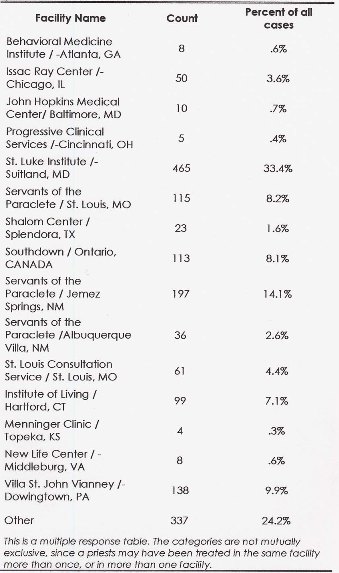 |
The survey respondents reported that 158 priests had been treated at a residential facility more than once. |
[Notes for the previous section are collected in a note section at the end of the Web version of this report, and every reference in the text is hyperlinked to the note itself.]
[notes 1-9 appeared on page 102 of the hardcopy report; note 10 is called out in the text but was not included on page 102]
[Continue to Part Six or return to Table of Contents.]